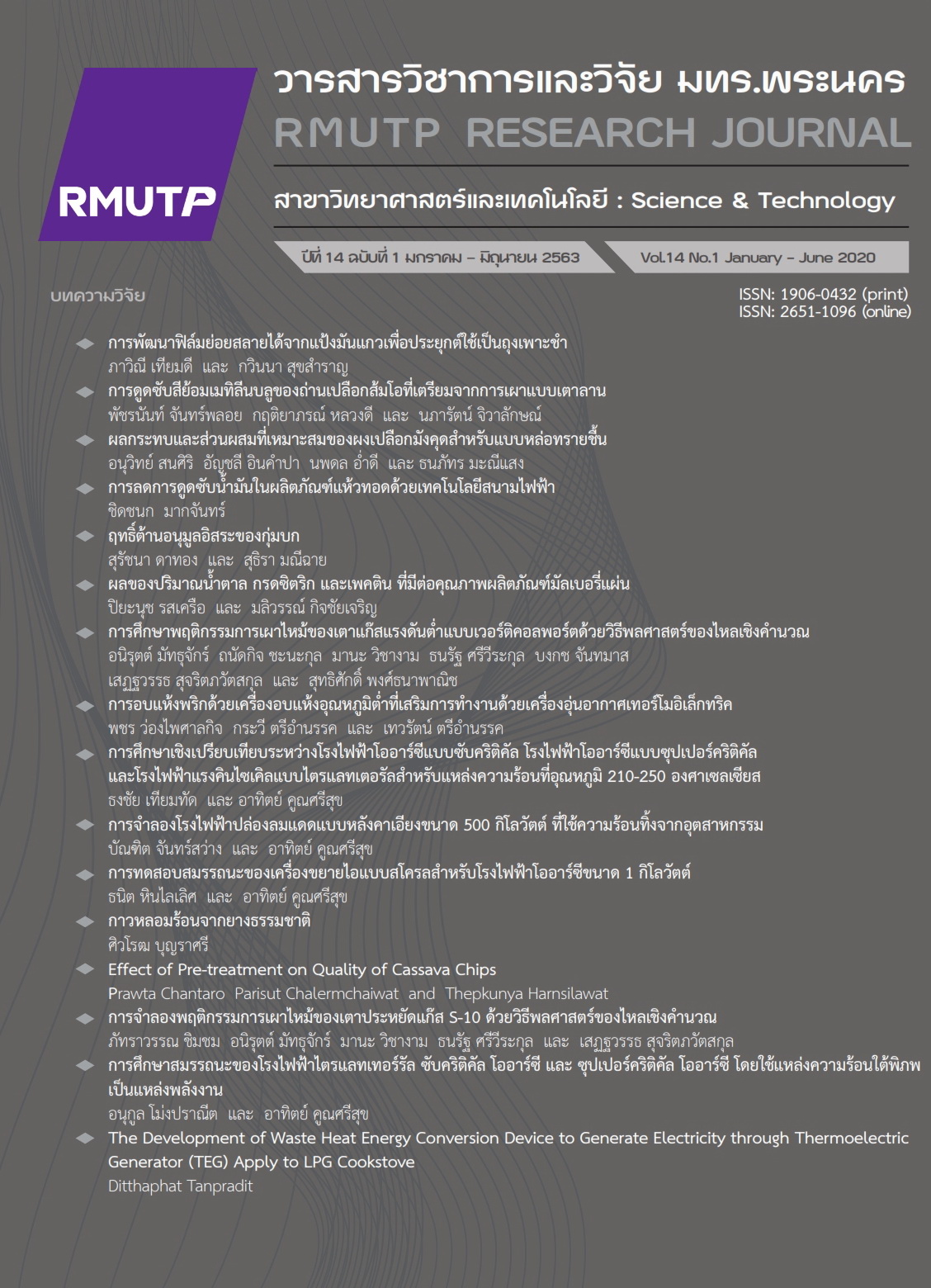Hot-melt Adhesive Production from Natural Rubber
Main Article Content
Abstract
The purpose of this research was to study hot-melt adhesives from natural rubber (Standard Thai Rubber 20, STR 20). In order to improve the adhesion and melting properties of hot-melt adhesive to get the best glue formula from STR 20, the ethylene vinyl acetate content (EVA), paraffin wax (Wax) and petroleum resin (Resin) were varied from 25, 50, 100, 125 and 150 phr (Part Per Hundred Rubber). It was found that the best adhesive formulas consisted of 100 phr of STR 20, 25 phr of wax, 150 phr of EVA and 150 phr of resin. For preparing hot-melt adhesive, first, the wax was heated and maintained at 160-170 ºC, then cut the STR 20 into small pieces and slowly added the rubber into the melted wax until the rubber was completely melted. And then added resin and EVA and cooled to room temperature, finally, the results show that hot-melt adhesive was dark brown, hard and odorless, smooth texture and easy to melt with 514±14 centipoises of Viscosity at 150 ºC, 82.49±1.4 lbf/in2 of shear strength and 2.06±0.02 kN/m of cleavage peel strength.
Article Details
References
A. Pizzi and K. L. Mittal, Handbook of Adhesive Technology, Revised and Expanded, Taylor & Francis, 2003.
Y. J. Park and H. J. Kim, “Hot-melt adhesive properties of EVA/aromatic hydrocarbon resin blend,” Int. J. Adhes. Adhes., vol. 23, no. 5, pp. 383-392, 2003.
Y. J. Park, H. S. Joo, H. J. Kim and Y. K. Lee, "Adhesion and rheological properties of EVA-based hot-melt adhesives," Int. J. Adhes. Adhes., vol. 26, no. 8, pp. 571-576, 2006.
H. H. Shih and G. R. Hamed, “Peel adhesion and viscoelasticity of poly (ethylene-co-vinyl acetate)-based hot melt adhesives. I. The effect of tackifier compatibility,” J. Appl. Polym. Sci., vol. 63, no. 3, pp. 323-331, 1997.
M. L. Barrueso-Martínez, T. P. Ferrándiz-Gómez, C. M. Cepeda-Jiménez, J. Sepulcre-Guilabert and J. M. Martín-Martínez, “Influence of the vinyl acetate content and the tackifier nature on the rheological, thermal, and adhesion properties of EVA adhesives,” J. Adhes. Sci. Technol., vol. 15, no. 2, pp. 243-263, 2001.
B. T. Poh, P. G. Lee and S. C. Chuah, “Adhesion property of epoxidized natural rubber (ENR)-based adhesives containing calcium carbonate,” Express Polym. Lett., vol. 2, no. 6, pp. 398-403, 2008.
B. T. Poh and Y. Y. Chang, “Viscosity and peel strength of SMR 10-based pressure-sensitive adhesives,” Polym. Plast. Technol. Eng., vol. 45, no. 11, pp. 1251-1256, 2006.
B. T. Poh and C. L. Chee, “Effect of coumarone-indene resin on adhesion property of SMR 20-based pressure-sensitive adhesives,” International Journal of Polymeric Materials and Polymeric Biomaterials, vol. 56, no. 3, pp. 247-255, 2007.
J. P. Kalish et al., “An analysis of the role of wax in hot melt adhesives,” Int. J. Adhes. Adhes., vol. 60, pp. 63-68, 2015.
L. L. Li and J. L. White, “Rheological behavior of highly filled epdm compounds with calcium carbonate, carbon black, silica and zinc oxide,” Rubber Chem. Technol., vol. 69, no. 4, pp. 628-636, 1996.
R. F. Grossman, The Mixing of Rubber, Springer Netherlands, 2012.
Z. S. Petrović, J. Milić, M. Ionescu and J. R. Halladay, “EPDM rubber plasticized with polymeric soybean oil of different molecular weights,” Rubber Chem. Technol., vol. 90, no. 4, pp. 667-682, 2017.
Z. S. Petrović, M. Ionescu, J. Milić and J. R. Halladay, “Soybean oil plasticizers as replacement of petroleum oil in rubber,” Rubber Chem. Technol., vol. 86, no. 2, pp. 233-249, 2013.
P. Jansen and B. G. Soares, “Effect of compatibilizer and curing system on the thermal degradation of natural rubber/EVA copolymer blends,” Polym. Degradation Stab., vol. 52, no. 1, pp. 95-99, 1996.
A. Sasikala and A. Kala, “Thermal Stability and Mechanical Strength Analysis of EVA and Blend of EVA with Natural Rubber,” Materials Today: Proceedings, vol. 5, no. 2, Part 3, pp. 8862-8867, 2018.
H. H. Kim and S.-J. Lee, “Effect of crumb rubber on viscosity of rubberized asphalt binders containing wax additives,” Con. Build. Mat., vol. 95, pp. 65-73, 2015.
D S.-S. Choi, S.-H. Im, J.-H. Park and J. S. Kim, “Analysis of wax solubility of rubber vulcanizates using wax solution in toluene and molten wax,” Polym. Test., vol. 28, no. 7, pp. 696-701, 2009.
A. Dorigato, M. V. Ciampolillo, A. Cataldi, M. Bersani and A. Pegoretti, “Polyethylene wax/epdm blends as shape-stabilized phase change materials for thermal energy storage,” Rubber Chem. Technol., vol. 90, no. 3, pp. 575-584, 2017.


